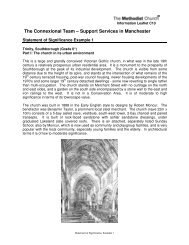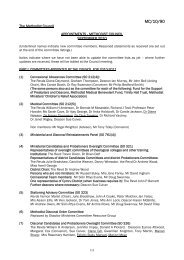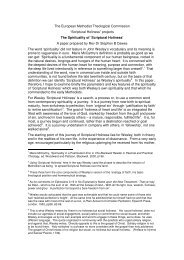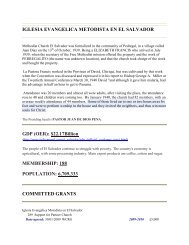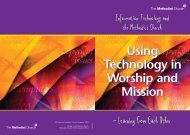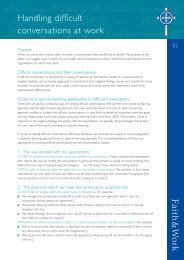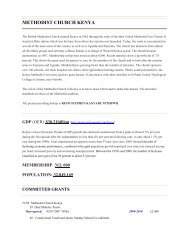Spiritual Health and the Well-Being of Urban Young People
Spiritual Health and the Well-Being of Urban Young People
Spiritual Health and the Well-Being of Urban Young People
You also want an ePaper? Increase the reach of your titles
YUMPU automatically turns print PDFs into web optimized ePapers that Google loves.
Contemporary approaches to measuring quality <strong>of</strong> life <strong>and</strong> well-beingThere is a huge range <strong>of</strong> contemporary responses to <strong>the</strong> question <strong>of</strong> what constitutes well-beingor ‘quality <strong>of</strong> life’ for children. Our literature search has indicated that a comprehensive review<strong>of</strong> <strong>the</strong>se approaches would require a substantial report in its own right. We restrict ourselveshere to identifying a few <strong>of</strong> <strong>the</strong> most prominent approaches which have recently been developedin <strong>the</strong> UK <strong>and</strong> in o<strong>the</strong>r countries, before going on to describe <strong>the</strong> approach which we havechosen to utilise for this report.One major relevant str<strong>and</strong> has been <strong>the</strong> development <strong>of</strong> <strong>the</strong> concept <strong>of</strong> ‘resilience’. Resiliencedoes not directly refer to quality <strong>of</strong> life, but ra<strong>the</strong>r to <strong>the</strong> factors which predispose people to have‘positive outcomes’ even in <strong>the</strong> face <strong>of</strong> adversity. According to O’Donnell et al (2002) resiliencein relation to children <strong>and</strong> young people was first conceptualised by Werner (1984) who definedit as:<strong>the</strong> ability to cope effectively with stress <strong>and</strong> to exhibit an unusual degree <strong>of</strong>psychological strength for one’s age <strong>and</strong> set <strong>of</strong> circumstances (O’Donnell et al, 2002:1266)The concept has been used to explore people’s resilience to a range <strong>of</strong> adverse events <strong>and</strong>circumstances. For example, Rutter (1985) looked at factors which protected againstpsychiatric disorder; Mrazek & Mrazek (1987) looked at resilience in child maltreatment victims;O’Donnell et al (2002) explored resilience in urban children exposed to community violence; <strong>and</strong>Flynn et al (2003) look at resilience amongst young people in care. Research into resiliencehas identified a wide range <strong>of</strong> protective factors in relation to children, <strong>the</strong>ir family, in <strong>the</strong>irinterpersonal relationships <strong>and</strong> in <strong>the</strong> community which are associated with more positiveoutcomes.A similar approach to identifying protective <strong>and</strong> risk factors has been taken by <strong>the</strong> Communitiesthat Care initiative which originated in <strong>the</strong> US <strong>and</strong> has recently been adapted <strong>and</strong> utilised in <strong>the</strong>UK (Beinart et al, 2002). This model looks at 17 risk factors in <strong>the</strong> family, at school, in <strong>the</strong>community <strong>and</strong> in peer relationships; <strong>and</strong> six protective factors. The <strong>the</strong>ory underpinning <strong>the</strong>model:sees <strong>the</strong> development <strong>of</strong> pro-social factors as a means <strong>of</strong> protecting children from <strong>the</strong>consequences <strong>of</strong> risk factors. Protective factors are seen as more cross-cutting <strong>and</strong>contribute to reducing risk in all areas. (Crow et al, 2004: 3)A different perspective is <strong>of</strong>fered by <strong>the</strong> New Economics Foundation’s approach to measuring<strong>the</strong> well-being <strong>of</strong> young people. A pilot study conducted in Nottingham (New EconomicsFoundation, 2004) focused on two aspects <strong>of</strong> well-being – life satisfaction <strong>and</strong> personaldevelopment:‘Personal development means being curious, <strong>and</strong> engaging in challenging <strong>and</strong>absorbing activities. Whilst most studies have only focused on life satisfaction, o<strong>the</strong>rresearch has shown that <strong>the</strong> second dimension <strong>of</strong> well-being, personal development, isimportant for people’s overall ability to cope well with life’s challenges ..’ (NewEconomics Foundation, 2004: 2)Key findings from this pilot study were that well-being fell as children got older, <strong>and</strong> that asmany as a third (32%) <strong>of</strong> <strong>the</strong> young people surveyed were ‘at <strong>the</strong> very least unhappy in life <strong>and</strong>may be at risk <strong>of</strong> mental health problems’ (New Economics Foundation, 2004: 2).Save <strong>the</strong> Children Fund have launched a regular publication which provides an independentsummary <strong>of</strong> information on <strong>the</strong> well-being <strong>of</strong> children in <strong>the</strong> UK. So far, two editions have beenproduced (Bradshaw, 2002; Bradshaw, 2005) focusing on a range <strong>of</strong> aspects <strong>of</strong> children’s livesincluding poverty; mental health; physical health; <strong>and</strong> time <strong>and</strong> space.The Government has also recently focused increasing attention on <strong>the</strong> dimensions <strong>of</strong> positiveoutcomes for children <strong>and</strong> young people. As part <strong>of</strong> <strong>the</strong> ongoing work within <strong>the</strong> Every ChildMatters agenda, a common outcomes framework has been developed (HM Government, 2004)which consists <strong>of</strong> five broad outcomes for children: ‘be healthy’, ‘stay safe’, ‘enjoy <strong>and</strong> achieve’,‘make a positive contribution’, <strong>and</strong> ‘achieve economic well-being’. Each outcome has a set <strong>of</strong>associated aims. For example <strong>the</strong> five aims which contribute to <strong>the</strong> ‘be healthy’ outcome are:physically healthy; mentally <strong>and</strong> emotionally healthy; sexually healthy; healthy lifestyles; choose3



